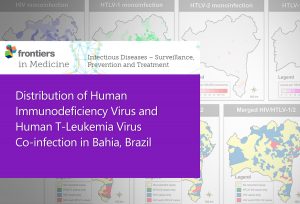A research by Fiocruz Bahia shows HIV and HTLV co-infection distribution
09/02/2022
Fiocruz Bahia
 A study analyzed the geographic distribution and the incidence of co-infection with a human T-lymphotropic virus (HTLV) and a human immunodeficiency virus (HIV) in Bahia, which is an endemic state for both retroviruses. The research was carried out using all samples submitted to serological tests at the Central Public Health Laboratory of Bahia (Lacen-BA), from 2004 to 2013. The total was about 130,000 samples from 358 of the 417 municipalities in Bahia. The research results, coordinated by Fiocruz Bahia researcher Maria Fernanda Grassi, were published in the Frontiers in Medicine journal. In the analyses, HTLV was detected in 2.4% of the HIV-positive samples and in 0.5% of those who tested negative, indicating an almost five-fold greater risk of HTLV infection in HIV-infected individuals.
A study analyzed the geographic distribution and the incidence of co-infection with a human T-lymphotropic virus (HTLV) and a human immunodeficiency virus (HIV) in Bahia, which is an endemic state for both retroviruses. The research was carried out using all samples submitted to serological tests at the Central Public Health Laboratory of Bahia (Lacen-BA), from 2004 to 2013. The total was about 130,000 samples from 358 of the 417 municipalities in Bahia. The research results, coordinated by Fiocruz Bahia researcher Maria Fernanda Grassi, were published in the Frontiers in Medicine journal. In the analyses, HTLV was detected in 2.4% of the HIV-positive samples and in 0.5% of those who tested negative, indicating an almost five-fold greater risk of HTLV infection in HIV-infected individuals.
Co-infection was found in 3.4% of the state's municipalities. The cities with the highest number of co-infections are important economic or tourist centers in Bahia, with the majority of cases in Salvador, which had 57% of co-infections. The age of these individuals ranged between 41 and 55. In addition, the incidence of co-infection was higher in women. The authors of the study note that the higher incidence in women can be explained by the mandatory serological triage of HTLV for pregnant women in the state after 2011, which contributed to a greater number of samples from women analyzed. The data suggest that HIV and HTLV co-infection in Bahia is a rare event. However, the researchers emphasize that it is important to identify risk factors for co-infection to develop effective actions in different epidemiological contexts, specific to each affected region.
HIV and HTLV
HTLV and HIV are retroviruses that belong to the same family and have no cure. HTLV, which is slightly known, does not destroy the immune system like HIV, but causes diseases such as leukemia, urinary incontinence, erectile dysfunction, and neurological problems. Bahia is the state with the highest number of cases of this virus in the country. The main means of transmission of both diseases are through sexual intercourse, breastfeeding, and contaminated syringe needles.
According to the article, previous studies indicate that co-infection with HTLV can interfere with the outcome of HIV infection. The research suggests that HTLV-1 may favor the emergence of opportunistic diseases, causing increased mortality, while co-infection with another type of virus, HTLV-2, may delay the progression of AIDS.


